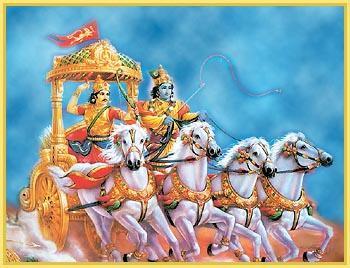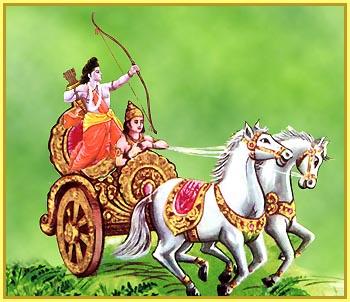Ashadh Sud 2 (23 June 2001), is Rath Yatra day. You may well wonder what Rath Yatra means. For Hindus it is a festive and meaningful occasion, where devotion to God is offered in a heart-warming manner.
"Rath" means chariot. "Yatra" means parade or procession. On this day, the murti of the deity is installed in a gorgeously decorated chariot and drawn by jubilant devotees through the open streets, so that people can have darshan.
Mahabharat RathMahabharat Rath

In the epic, Mahabharat, before the stupendous battle Bhagwan Shri Krishna puts a proposal to both Duryodhan and Arjun who come to seek his help. Duryodhan chooses the army of Krishna and Arjun takes Krishna on his side in spite of his pledge that he would remain weaponless. Krishna becomes the chariot driver (sarathi) of Arjun. Arjun is the rathi or owner of the chariot. The fighting has to be done by the rathi while the sarathi drives the chariot. The skill and expertise with which the sarathi manoeuvres the chariot throught the enemy ranks enables the rathi to exercise his prowess. A good rathi but a poor sarathi invariably spells defeat or death for the rathi.
Even though the orders on how to fight and the battle arrangements came from other stalwarts called maharathis, the Pandavas were more than happy to have Krishna on their side, for they knew that Krishna was not a mortal being and hence not a normal sarathi with human limitations.
On the eve of the battle, Duryodhan, leader of the Kauravas, sends his chariot driver Uluk into the enemy camp. Uluk insults and humiliates Krishna and the Pandavas, stoking rage and fury. The Pandavas are on the verge of pouncing upon Uluk but Krishna pacifies them. He addresses the messenger, "Uluk! Suppose you ride your chariot beyond the three worlds (trilok) or take it and hide in the underworld (patala), still, I can bring Arjun's chariot before you on the morrow."
The words of Shri Krishna reflect his adeptness in chariot driving and his spirit to lead the Pandavas to victory. No matter where the enemy goes, Krishna is ready to take Arjun before them.
The climax of the Rath saga in the Mahabharat comes at the end of the battle, where millions on both sides have been slaughtered on the battlefield. The Pandavas make their way into the eerie silence of the enemy ranks in Arjun's chariot, to pay respects to the dead. One by one they step off the chariot. Lastly, Krishna says to Arjun, "You step off first and I'll follow." Now this seemed a little strange. During the battle days, Arjun and Krishna had stepped off from the chariot many times without sequence. So why does Krishna specifically instruct Arjun to step off before him? Seeing Arjun's questioning look, Krishna assures him, "It is in your benefit." Arjun instantly obeys Krishna and steps down. Krishna follows him and the whole chariot bursts into flames. The Pandavas just look on dumbfounded. "What has happened?" they question silently. "How is it that the great chariot, which had led them to victory, without any rhyme or reason has turned into a fireball?" Krishna then explains, "Drona, Ashwathama and other warriors among the Kauravas had shot their devastating weapons like the Brahmastra at the chariot. But because of me the chariot had stayed intact all the while. Today, with our task accomplished, I have abandoned it for good and hence you see it consumed by flames."
Similarly, God protects us but as soon as He abandons us our life's chariot burns into cinders, i.e. our life becomes meaningless. When the atma leaves the material body - the chariot - the body becomes lifeless. It becomes useless. Glory be to the soul who lives a noble, charitable life. A life in tune with God's injunctions. It's worthy for such a soul's lifeless chariot (body) to be burnt on a funeral pyre.
Ramayan RathRamayan Rath

In the epic, Ramayan, a similar parallel is to be found. When Kumbhakaran, Indrajit and other evil elements have been killed, Ravan is angered. Brimming with fury and rage, armed to the teeth, he thunders into the battlefield in his chariot to kill Ram. Seeing this, Vibhishan becomes anxious for Ram's life. Ram then coolly explains to Vibhishan, "Oh friend! Behold my chariot through which I am always decidedly victorious. Courage and tenacity are its wheels, immutable truth and character are its flags; strength, discrimination, self-control and charity are its horses; forgiveness, mercy and equanimity are the reins and devotion to God is its sarathi.
Any man, who, according to Shri Ram, lives a noble life, with courage and tenacity, powered by the spirit of truth, discrimination, self-control and blessed with a generous heart abounding in forgiveness, charity and devotion to God, can fare undefeated through the stormy straits of life.
Ram adds further, "Oh friend! Whoever possesses such a chariot can never be defeated. With this chariot he can not only subdue minor temptations but transcend the trappings of this material world.
Shrimad Bhagvat Rath
The jewel in the crown of Bhakti scriptures is the priceless Shrimad Bhagvat.
The rathi of Shrimad Bhagvat is different from the battlefields in the above two epics. Here the rathi symbolizes love.
The story is that one early morning, while some Gopis were going to milk cows and to fill water pots from the river Yamuna, they see a dazzling chariot on the outskirts of their village. They surmise that a kingly personality has come to visit Gokul. Slowly they learn that Akrur has come from Mathura to collect Krishna - their beloved. They become hysterical and forgetting their chores run straight for the chariot.
They surround it thinking all the while how to prevent their loved one from leaving. He is our life, our prana (life-force). How can we live without him? How will we experience bliss in his absence? What joy will there be without him?" And with these frantic thoughts they decide to stop the chariot by any means. Some plan to lie across its path, some resolve to hold the reins of the horses, some even decide to throw themselves in front of the chariot if it starts moving. The Gopis were prepared to die rather than be separated from God. Such was their profound love for Shri Krishna. But as Krishna emerges from "Nandbhavan" (father Nand's place), he glances at them just once and a path is created instantly for him - the Gopis give way. What happened to all their brave plans? Krishna climbs into the chariot. Not a word is exchanged and yet the message has been understood. The reins are pulled, the horses neigh, the wheels turn and soon the peacock feather recedes further and further until it is seen no more. The Gopis are still standing there, speechless, watching their beloved depart. Why didn't they do anything?
It is said that when Krishna glanced at the Gopis, they saw in his eyes a profound desire to go. Immediately they gave up their resolves. Serving their master's wish was of paramount importance to them.
The chariot of the Shrimad Bhagvat portrays ideal devotion. Devotion means following the wish, the will, the desire, the order of one's divine master. Whatever one may decide, however, lovingly or with devotion, but to alter one's wish or completely overrule it and live to the Lord's wish qualifies a true devotee.
The Upanishad Rath
The profoundest and most practical, philosophical wisdom in the world are to be found in our Upanishads.
The story of the Upanishad Rath is found in Katha Upanishad (1:3/3,4)
After a three day fast by the young spirited Nachiketa at the doors of hell, Lord Yam is pleased and tells Nachiketa to ask for three boons. Nachiketa however has one supreme desire; to attain the knowledge of Brahman or "Brahma Vidya." Yam tempts him with worldly offerings but he remains resolute.
Yam becomes pleased. He begins to impart the supreme knowledge.
Atmãnam rathinam viddhi shariram rathameva tu |
Buddhim tu sãrthim viddhi manaha pragrahameva chha ||
Indriyãni hayãnyãhurvishayãnsteshu gocharãn |
Ãtmeindriyamanoyuktam bhoktetyãhur manishinaha ||
(Katho Upanishad, 1 - 3 - 3,4)
"The atma is the rathi, the body is the rath, the intellect is the sarathi, the mind is the rein, the senses are the horses and the "vishayas" (material objects) are the fields of pasture."
Herein lies the story of the sojourn of life (jivan yatra) for which we have been given the rath, (the body).
The chariot, the wheels and the horses all symbolize motion or travel. The chariot is not to be kept stationary or in a "garage" or on display in a museum. The sage of the Upanishad is telling us here to keep our body (chariot) active, always engaged in good deeds. If the horses are left to roam free they'll become unmanageable and wild, doing anything they please. But if they are harnessed together to a chariot with a driver they'll run with a single motive towards a specific goal. Similarly, the senses, if left to run free will create havoc for the rathi e.g. "feeding" on anything and everything without discrimination and if they are directed by a sarathi they'll be guided towards a fixed goal.
In the 5th verse, the sage elaborates further:
Vignãnsãrthir yastu manaha pragrahavãn naraha |
Sodhvanaha pãramãpnoti tad vishnoho paramam padam ||
i.e. the man whose "Sarathi" (intellect) is knowledgeable, wise, alert and discriminative, whose reins (the mind) are in full control, only that man is able to traverse the path of samsara (material life), reaching the desired goal, that is, Bhagwan Vishnu's Supreme abode.
In this chariot, the rathi is atma. The horses, reins and drivers are the senses, mind and the intellect. The center of attraction is rathi - the owner. The chauffeur will always drive with the best intentions of pleasing his boss. Similarly, the sarathi (intellect) drives with the best intentions for the boss (atma) and that is very necessary. He does not over-whip the horses, nor does he run them at a dead pace, but at a pace suited for the rathi. That is decided by the sarathi. The "best intention" for the rathi is redemption (moksha). For that the mind, the intellect and the senses work together to take the soul towards redemption.
By imbibing this concept of Rath Yatra given in the Upanishads our life's pilgrimage to eternity will proceed forward without hindrance.
Rath Yatra is a festival of accepting God's All-doership in life.
On 11-7-83 a Rath Yatra festival had been celebrated in the presence of Pramukh Swami Maharaj at the Amdavad mandir. A small, beautiful chariot equipped to move was set up for the festival. On the previous night the chariot was tested and re-tested. It worked perfectly. The next morning after Swami completed his morning prayers he came to perform arti of Harikrishna Maharaj seated in a small exquisite chariot. The chariot would not move due to technical fault. The gadgetry some how failed to operate. Later, in Swami's room someone said, "The chariot was in working order in the night and it failed at the last moment. I just don't understand why." Swami answered, "It is the wish of Maharaj. He probably wanted to give darshan in a motionless chariot." The words of Swamishri revealed the spirit of the Rath Yatra festival. After having handed the reins to God, it is His wish that prevails. He may give you joy or sorrow, wealth or poverty, fame or shame in spite of your sincerity and effort. Believing that He is the all-doer makes life happier and worth living.
(For more details refer to 'Hindu Festivals and Rituals')